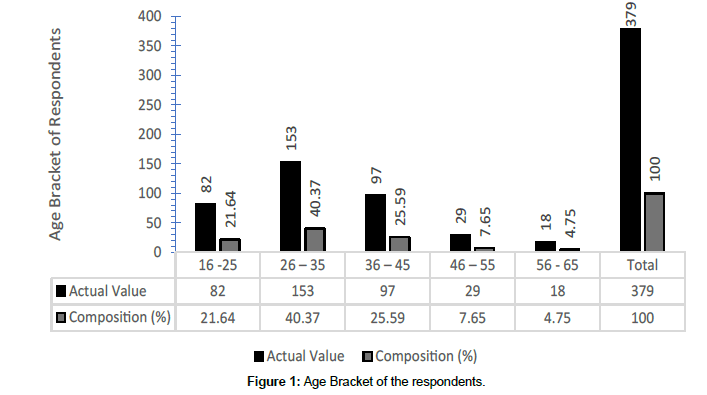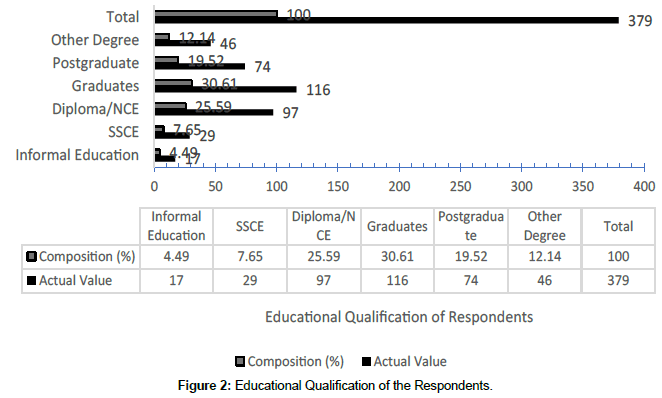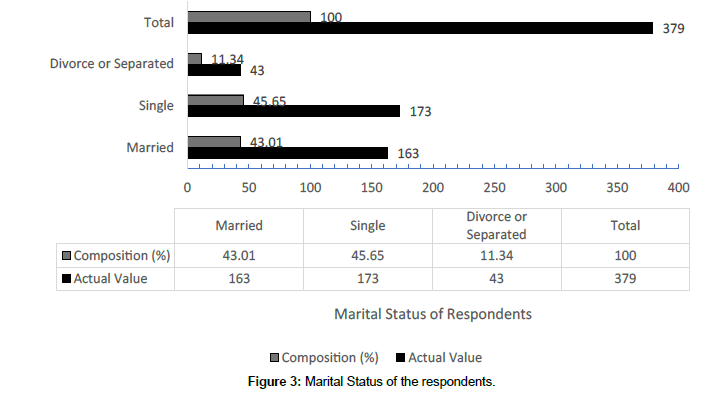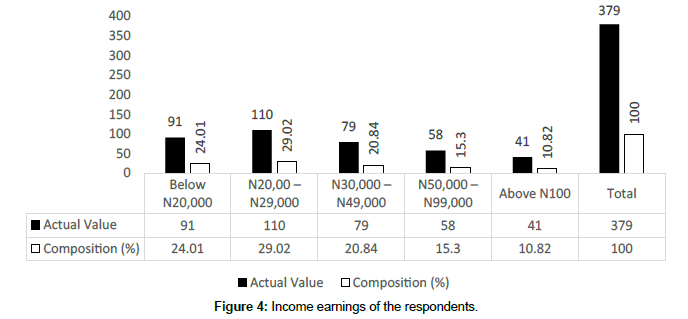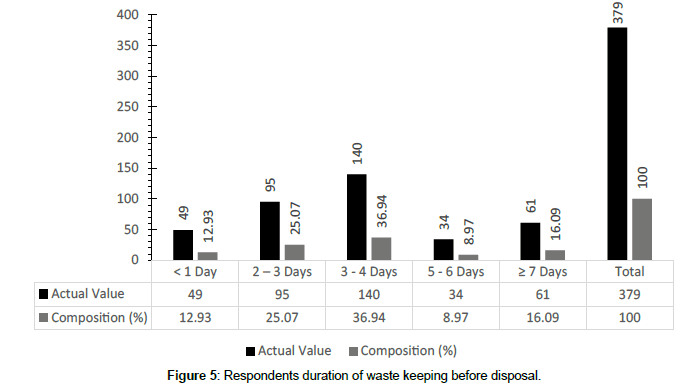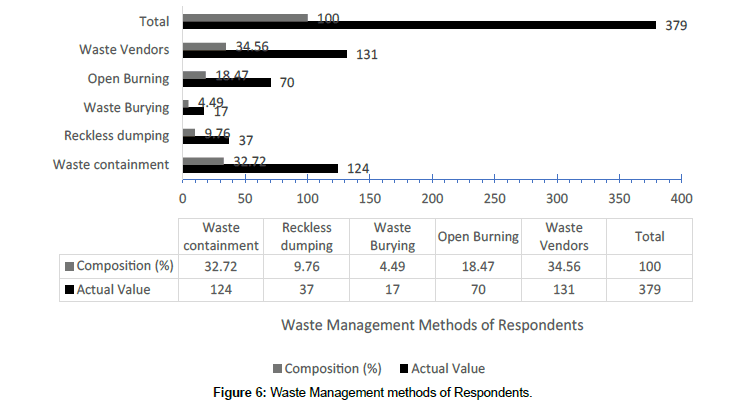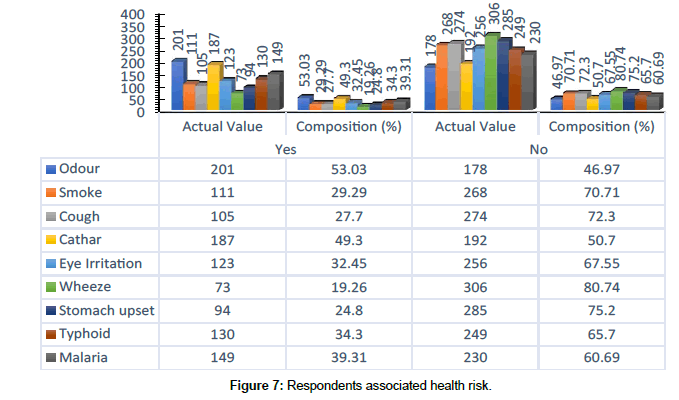Research Article, J Med Toxicol Res Vol: 1 Issue: 2
Socio-Economic and Health Impact Assessment (Shia) of Municipal Solid Wastes in the Niger Delta: A Case Study of Yenagoa Metropolis, Bayelsa State
Tariwari CN Angaye*
Department of Biological Sciences, Faculty of Science, Niger Delta University, Wilberforce Island, Bayelsa State, Nigeria
*Corresponding Author : Tariwari C.N Angaye
Department of Biological Sciences, Faculty of Science, Niger Delta University, Wilberforce Island, Bayelsa State, Nigeria
E-mail: maktarry@yahoo.com
Received: April 12, 2018 Accepted: May 29, 2018 Published: June 04, 2018
Citation: Angaye TCN (2018) Socio-Economic and Health Impact Assessment (Shia) of Municipal Solid Wastes in the Niger Delta: A Case Study of Yenagoa Metropolis, Bayelsa State. J Med Toxicol Res 1:2.
Abstract
The problem posed by improper management of municipal solid wastes (MSW) is becoming alarming. The socio-economic and health impact assessment (SHIA) of MSW was carried out using questionnaires and interviews. Emerging results shows that out of 400 questionnaires were dispatched of which only 95.75% (379) were returned. Out of the respondents 42.22% (160) were female, while 57.78% (219) were male, with predominant age bracket in the ranged of 22-45 years. Marital status showed that 41.10% (163) are married, 48.11% are single, while 10.83% (43) are either divorced or separated. Survey of educational status of the respondents indicated 4.99% (17) had no formal education, 7.65% (29) had First School Leaving Certificates, 25.60% (97) had Diploma and NCE, and 19.52% (74) were University Graduates, while 30.61% (116) and 12.14% (46) were postgraduate and Advanced Degrees holders respectively. As at the time of this study US$1=N375, Notwithstanding, 58% of the all respondents are either employed or self-employed. In terms of income earning, 23.93% earn less than N20,000, 29.00% earn between N20,000–N29,999; 21.00% earn between N30,000–N49.999, 15.37% earn between N50,000–N99.999, while 10.83% earn above N100,000. Based on interviews from waste scavenger the most economical viable wastes are scrap metals and plastic/rubber. Unfortunately, there was no reported case of waste segregation, while only 32.75% bag their waste and have proper temporary waste containers, 9.82% throw their waste away, 4.53% bury their waste, 18.40% burn their waste, 34.51% use waste vendors. Predominant vectors associated with the waste are Cockroaches, rats and flies. Based on our finding we therefore urge Government to enact laws that will deter precarious management of waste, encourage waste recycling and segregation as well as provide waste treatment facilities in order to mitigate the adverse impacts posed by MSW streams.
Keywords: Municipal waste; Socioeconomic impact; Niger delta; Bayelsa state
Introduction
According to the United Nations Environmental Programme (UNEP), wastes are seen as materials regarded of no further application or benefit for consumption, production and transformation [1]. Notwithstanding, solid wastes are also referred to as needless or ready to be discarded substances, which can be solid or semi-solid, cannot be retained for further use, as well as having no economic value or further resourceful application or value to the user. Based on origination, waste streams referred to as MSWs includes but not limited to Household Solid Waste (HSW), Commercial waste, Industrial waste, electronic waste, construction waste, Agricultural waste, Mining waste, Medical waste etc.[2].
According to the United State Environmental Protection Agency (USEPA) [3], components or characters of MSWs basically includes but unlimited to; plastic, metals, paper, vegetable matter, textiles, rubber, and glass. Estimates of the World Health Organisation indicated an annual solid waste generation of whose mass is about 1.375 billion tons, with an expected 20 % increase whose mass is likely to surge to about 2.2 billion tonnes by the year 2025, with logistic cost of about $375.5 billion [4].
As reported by Adejobi et al. [5] it is established that in Nigeria, there is a steady rise in rural-urban immigration as a result of desire of the rural populace to meet up or comprehend contemporary technological advancement. Unfortunately, this population rise and its associated activities have resulted in large volume of waste streams that have been poorly handled, due to inefficient, insufficient and inappropriate sanitary facilities. Consequently, waste streams are handled poorly resulting to environmental pollution. As reported by Adamu et al. [6] the illicit disposal of MSWs has had its adverse effects on the ecosystem, in addition of posing environmental, socioeconomic and health impacts depending on the management strategy [7,8]. For instance, air pollution incur a global expenses of $5 trillion resulting from losses associated with productivity and reduced quality of some basic resources [9]. As established in literature, there is a very strong correlation between waste and public health [10]. Hence the SHIA is hereby investigated.
Methodology
Techniques for data acquisition
The method of data acquisition was through interviews and administration of questionnaires. A total of 400 questionnaires/ interviews were administered or granted to respondents within the metropolis in order to acquire envisaged socio-economic and health impact data of MSWs. The questionnaires were collated based on socioeconomic and health variables such as; Educational status, Income earning, waste management method, potential health risk vectors associated with the dumpsites.
Results and Discussions
Generally, results on socioeconomic and health impact assessment (SHIA), of the respondent showed that, based on the survey, emerging data shows that out of 400 (100%) questionnaires dispatched, only 95.75% (379) were returned. Out of the respondents, based on age brackets 57.77% (219) were reported as male, while 42.23% (160) were female. As presented in Figure 1, respondents within age bracket in the ranged of 16-25 years were 21.64% (82). The result showed that respondents whose age bracket, fall within the range of 26-35 years were 40.37% (153), which was highest amongst all respondents for age bracket. It was further established that, respondents within age bracket ranging from 36-45 years were 25.59% (97). While 7.76% (29) of the respondents were within age bracket of 46-55years, 4.75% (18) were within the ages of 56-65 years.
Figure 2 presents the educational qualification of the respondent. Amongst the respondents 53.29% (202) were males, while 44.58% (177) were females. Notwithstanding, Results showed that 4.49% (17) of the respondents had informal education, which was lowest amongst all respondents. Respondents who had Senior Secondary Certificate Exam qualification (SSCE), represents 7.65% (12). Results of respondent having Diploma/National Certificate Exam (NCE) was 25.59% (97). Furthermore, results showed that respondents who were tertiary institution graduates were highest amongst all respondent representing 30.61% (116). Respondents who had postgraduate degree were 19.52% (74). In addition, results of respondents with other forms of technical and artisanal qualification represents 12.14% (46), as presented in Figure 2.
As presented in Figure 3, results on the marital status of the correspondents showed that out of 379 (100%) retrieved questionnaires there were 49.61% (188) male and females with value of 50.39% (191). Furthermore, results indicated that respondents who were married represent 43.01% (163) of all respondents. Furthermore, result also indicated that respondents who were single were highest representing 45.65% (173). In addition, respondents who were either divorced or separated recorded the lowest value of 11.34% (43). Figure 4 presents the income earnings of the correspondents. Out of the 379 questionnaires administered a total of 207 males which represents 54.61% responded to the questionnaires, while the remaining 44.91% (172) were females. Furthermore, respondents whose income were below N20,000 was highest amongst all respondents and represents 24.01% (91). Income earners within the ranged of N20,000–N29,000 were represents 29.09% (110) of respondents. Furthermore, results also indicated that respondents whose income were within the range of N30,000–N49,000 represents 20.84% (79).
Furthermore, higher income earners within the range of N50,000–N99,999 were 15.30% (58) as presented in Figure 4. The lowest amongst the respondents who have the income earning above N100,000 represents 10.82% (41). For instance, a study by Ogunrinola et al. [10] on the comparison exposure levels of dumpsite pollutants between self-employed and wage income earners in Lagos state showed that, the self-employed earn less (N27,000), and are more exposed compared to wage income earners (N31,000) who work outside their abode and less exposed.
Out of the 379 questionnaires retrieved, Survey on respondent’s duration of waste keeping before disposal showed that 49.34% (187) males responded as well as 50.66% (192) females. Based on the individual variables of the respondents; it was observed that 12.93% (49) of respondents evacuate their waste in less than 24 hours (Figure 5). Also, respondents who evacuate their waste between 1-2 days were represent 25.07% (95) amongst all respondents. A study by Ulaeto et al. [11] on the waste disposal methods Akwa Metropolis of Anambra state showed that, 31.1% and 12.6% of respondents indicated that waste streams are usually cleared once a week and once in a month respectively. Between 3-4 days it was reported that 36.94% (140) of respondent dispose their waste. Furthermore, result reported showed that lowest amongst the respondents took 5-6 days for 8.97% (19) of respondents to dispose their waste. In addition, some respondent who keep their waste for over 7 days before disposal represent 16.09% (61).
The waste management methods of the respondents were assessed and result showed that out of the 379 (100%) respondents. Based on their sex distribution 49.34% (187) of the respondent were male, while 50.66% (192) were females (Figure 6). Notwithstanding, result indicated that respondents who had means of waste containment (thrash can) were 32.72% (124). It was also observed that 9.76% (37) of the respondents dump their waste recklessly (Figure 6). Furthermore, respondents who bury their waste were lowest and represent 4.49% (17) of the respondents. Result also indicated that respondents who practice open burning of waste represent 18.47% (70) amongst all respondents. It was also observed that highest amongst the respondents use waste vendors to evacuate their waste representing 34.56% (131) of the respondents (Figure 6).
A study, while only 34% of waste streams are packaged for disposal, 61.20% prefers to burn their waste in open air and another 2.9% prefers burying their waste, also showed that about 42.7% of waste are usually retained from dumpsites by waste scavengers [11]. Another study conducted on the assessment of MSWs in Ilorin west Local Government Area of Kwara state indicated different methods of waste disposal including; communal dumping, regulated dumping and other forms of illicit dumping in canals, drainages and in the street. The study by Oyekan and Sulyman [12] also showed that; in Ajikobi district, 56% dump their waste in the street, while 41% burn their waste in Magaji district, and another 33% in Alamu district use regulated dumpsite provided by Government.
As presented in Figure 7 the potential health risk of poor management of waste amongst the respondents based on sex distribution result showed that out of the 379 respondents, representing 48.02% (182) male and 51.98% (197) females. Notwithstanding, amongst the correspondents, 53.03% (201) were affected by foul odour of MSWs, as opposed to 46.97% (178). As a result of open burning of MSW, 29.29% (111) of the respondents were affected by smoke, as opposed to 70.71% (268). Furthermore, 27.70% (105) had cough as a result from inhalation from MSWs; on the other hand, 72.30% (165) of respondents had no incident of cough. Result showed that the respondents who had catarrh associated with MSWs were 49.30% (187) as opposed to 50.70% (192) that indicated no case of catarrh (Figure 7). Also eye irritation (peppering), was indicated amongst 32.45% (123) of male respondents, as opposed to a higher 67.55% (256) of respondents who had no case of eye irritation. Results showed that 19.26% (73) cases of wheeze was reported amongst the respondents compared to a higher 80.74% (306) of respondents who indicated no incident of wheeze (Figure 7).
Cases of stomach upset were reported amongst 24.80% (94) of respondents, compared to a higher number of respondents that indicated no incidence of stomach upset representing 75.20% (285). Meanwhile, respondents indicating cases of typhoid fever had value of 34.30% (130), as opposed to higher number of respondents that indicated no case of typhoid fever, with values of 65.70% (249). The incidence of malaria associated with MSWs was indicated amongst 39.31% (147) of male respondents. On the other hand, respondents with no cases of malaria were higher with value of 60.69% (230). Inhabitants close to dumpsites have become more liable to diseases, 49.5% incidence of malaria was reported amongst the respondents closer to dumpsites, as opposed to 22% and 28% cases that are further and farther respectively [10]. It was also established that higher income earner are less prone to ailment associated with pollution.
Conclusion
This research investigated the Socioeconomic and Health Impact Assessment (SHIA) of Municipal Solid Waste of Yenagoa Metropolis of Bayelsa State in Nigeria. Results of the SHIA survey showed that the populace need to be further sensitized on waste segregation, reduction, reuse and recycling. In addition, the aspect of legislation needs to be enforced in order to deter earing populace from anthropogenic activities on one hand; on the other hand, Government needs to urgently formulate policies that will aid waste recycling, reduction and reuse. This will create employment for the populace and further reduce the anthropogenicity associated with municipal solid waste.
References
- UNEP (2006) Environmental law and policy to assess environmental health and ecosystems vitality of 149 countries worldwide. Year Book-Environmental Performances Indicators, Yale University, USA.
- Uba S (2015) Environmental impact assessment of dumpsites in zaria metropolis, Kaduna state, Nigeria.
- United State Environmental Protection Agency-USEPA (2015) Health particulate matter air and radiation.
- WHO (1999) Guideline for drinking water quality 2nd edition recommendation. Geneva, Switzerland 1: 30-113.
- Adejobi OS, Olorunnimbe RO (2012) Challenges of waste management and climate change in Nigeria: lagos state metropolis eperience. African J Sci Res 7: 346-362.
- Adamu IM, Dibal HI, Duhu BY (2014) Disposal and management of solid waste in damaturu, yobe State, Nigeria: challenges and implications. Journal Environmental Issues and Agriculture in Developing Countries 6: 54-63.
- Eshalomi-MarioTN, Tanee FBG (2015) Phytodiversity assessment in abandoned solid waste dumpsites in port harcourt, Nigeria. Annu Res Rev Biol 6: 379-389.
- Nnodu VC, Okoye CO, Onwuka SU (2008) Urban environmental problems in Nigeria. Rex Charles and Patrick Publication. Anambra.
- World Bank Group (2016) The Cost of air pollution: strengthening the economic case for action. World Bank and the institute for health metrics and evaluation at the University of Washington, USA.
- Ogunrinola IO, Adepegba EO (2012) Health and economic implications of waste dumpsites in cities: The case of lagos, Nigeria. Int J Eco Fin 4: 239-251.
- Ulaeto SB, Nnorom IC, Alisa CO, Ewuzie U (2015) Survey of waste disposal methods in awka metropolis. J Appl Sci Environ Manage 9: 322-316.
- Oyekan TK, Sulyman AO (2013) Health impact assessment of community-based solid waste management facilities in Ilorin west local government area kwara state, nigeria. J Geogr Reg Plan 8: 26-36.
 Spanish
Spanish  Chinese
Chinese  Russian
Russian  German
German  French
French  Japanese
Japanese  Portuguese
Portuguese  Hindi
Hindi 